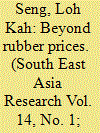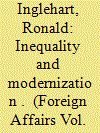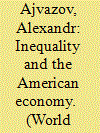|
|
|
Sort Order |
|
|
|
Items / Page
|
|
|
|
|
|
|
| Srl | Item |
| 1 |
ID:
073068


|
|
|
|
|
| Publication |
2006.
|
| Summary/Abstract |
This paper looks at life in Singapore during the Great Depression in the early 1930s from the perspectives of the ordinary people who lived through it. Besides discussing the slump's impact on businesses, wages and employment, it examines how effectively people responded to the crisis. Their distress was alleviated by immigration controls and a fall in the cost of living at the societal level, and also by mutual help, based on family and kinship ties, at the individual level. It appears that life for many people was not as difficult as might be supposed. The quality of life, reflected in indices such as mortality and crime, seemed generally satisfactory after 1930, while the island was also spared serious social and political upheaval.
|
|
|
|
|
|
|
|
|
|
|
|
|
|
|
|
| 2 |
ID:
124297


|
|
|
|
|
| Publication |
2013.
|
| Summary/Abstract |
From the turn of the century up until the 1930s, public education under Dutch rule in Indonesia developed both quantitatively and qualitatively, but this expansion was interrupted, and even reversed, by the onset of the Great Depression. Focusing on schoolteachers in particular, this essay examines the trajectory of education policies in colonial Indonesia in response to the crisis, from the initial measures, to partial recovery in the mid-1930s, up to the Japanese invasion of 1942. The crisis ushered in the policy of indigenisation, which saw large-scale education reorganisation, including the substitution of European teachers with much lower paid Indonesians. Indigenisation was also a political response to the spreading of nationalist ideals through the growing number of independent schools run by Taman Siswa and the Muhammadiyah. Hence, the intention was also to transform Indonesian teachers into cultural agents who would propagate a government-formulated concept of cultural identity among their own community. However, indigenisation contributed to the gradual delegitimisation of colonial authority through the exodus of well-educated Indonesians who had been intended as docile imperial subjects.
|
|
|
|
|
|
|
|
|
|
|
|
|
|
|
|
| 3 |
ID:
142689


|
|
|
|
|
| Summary/Abstract |
During the past century, economic inequality in the developed world has traced a massive U-shaped curve—starting high, curving downward, then curving sharply back up again. In 1915, the richest one percent of Americans earned roughly 18 percent of all national income. Their share plummeted in the 1930s and remained below ten percent through the 1970s, but by 2007, it had risen to 24 percent. Looking at household wealth rather than income, the rise of inequality has been even greater, with the share owned by the top 0.1 percent increasing to 22 percent from nine percent three decades ago. In 2011, the top one percent of U.S. households controlled 40 percent of the nation’s entire wealth. And while the U.S. case may be extreme, it is far from unique: all but a few of the countries of the Organization for Economic Cooperation and Development for which data are available experienced rising income inequality (before taxes and transfers) during the period from 1980 to 2009.
|
|
|
|
|
|
|
|
|
|
|
|
|
|
|
|
| 4 |
ID:
138044


|
|
|
|
|
| Summary/Abstract |
Economic inequality in the US and most countries has risen sharply in the last few decades. This article analyses the process that accounts for the growing concentration of capital and draws paralles with the state of affairs which resulted in the great depression.
|
|
|
|
|
|
|
|
|
|
|
|
|
|
|
|
| 5 |
ID:
094812


|
|
|
|
|
| Publication |
2010.
|
| Summary/Abstract |
Prior to World War II, the U.S. Army numbered 187,000 soldiers. Its growth to more than 8 million was a significant accomplishment. Little known to most, the Franklin D. Roosevelt administration's youth program, the Civilian Conservation Corps (CCC), provided the pretrained manpower to fill the U.S. Army's ranks upon mobilization with men who readily assumed the role of Non-Commissioned Officers (NCOs). It also gave Organized Reserve Corps officers the opportunity to occupy leadership positions, an experience that would have been unavailable otherwise. By the same token, it allowed the Regular Army to assess the leadership potential of both Regular and Reserve Officers in leading future citizen soldiers. Last, it provided the Army with an opportunity to exercise its mobilization plans.
|
|
|
|
|
|
|
|
|
|
|
|
|
|
|
|
|
|
|
|
|